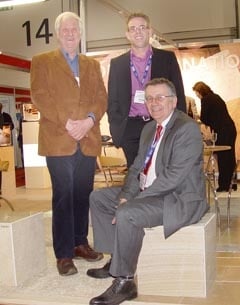There was a new name among the French suppliers of stone at the Natural Stone Show in March, even though there were familiar faces on the stand.
The stand was that of MB Stone International and the familiar faces those of Chris Tottle and Maurice Buisson, who many will associate with Anglo-European Stone.
Exhibited on the stand was a range of stones (many also familiar, although some were new) from central France and Normandy.
In fact, the M B in MB Stone stands for Maurice Buisson, who, in partnership with Chris Tottle, has run Anglo-European Stone for the past six years following the exit from the market of their previous employer, Guinet-Derriaz.
Chris Tottle retires this year after 35years in the stone industry, during which he was President of Stone Federation Great Britain in 1995/96. His place at MB Stone is being taken by Ian Munns, who will sell the French stones from a new office in Ascot.
Ian joined the stone industry as a mason fixer and progressed into management. His most recent jobs used the French limestones of the companies he will now represent.
His experience in fixing will be invaluable to clients, who often seek technical advice from a stone supplier before committing to a particular source.
The creation of MB Stone International has come about as the result of one of a number of upheavals in the French Stone industry over the past few years.
They have resulted in a realignment of companies and individual loyalties, and it seems now that stone from France has settled into three main camps.
Rocamat continue. There has been the emergence of La Pierre de France, who also exhibited at the Natural Stone Show and whose impressive stand featured white limestone under a lightweight canopy of stone on aluminium honeycomb, which drew an admiring audience. And there is MB Stone.
Like Anglo-European before them, MB Stone represent a consortium of quarry-owning and stone processing companies in France who have amalgamated their marketing efforts for export in order to be able to reach a larger market with a wider range of products than any of them could achieve on their own.
The companies involved are: Carrières de la Plaine de Caen, Carrières et Marbreries de Comblanchien, Euromarbles, Francepierre, Poitou-Charente, MDB, Masson SA, Vermorel SA and Yelmini-Artaud.
The stones they sell include Caen Stone from Normandy, the reintroduction of which is one of the notable successes of MBS. It comes from an original source re-opened after a geological fault that had brought production to a halt previously was circumvented.
This has made stone available for British Cathedrals built using Caen (Canterbury, Norwich, Chichester, Winchester and Exeter). The stone was also recently selected to replace original Caen Stone on part of Buckingham Palace.
The brand leader of the MBS range remains Chandor, with several large projects to its credit. In the UK, it was notably used for Paddington Span 4 and The Central Square in Brixton.
Other stones that have joined the MBS stable recently include: from the west Poitiers Area, Bretigny and Sireuil, two white limestones whose large, deep-bed wire-cut block will be welcomed for its cost effectiveness; from Burgundy, Chamesson, a newly opened quarry to add a further Portlandia limestone; St Martin Belleroche and Corton, beige/pink hard limestones from Midi Pyrennées; and Molière sandstone, with its cream colour enhanced with gold striations.

